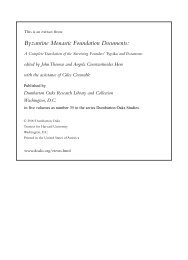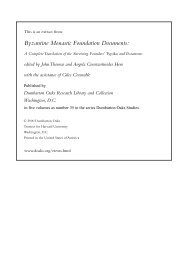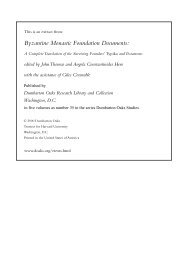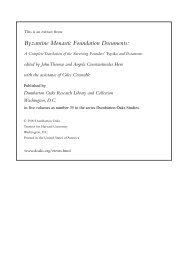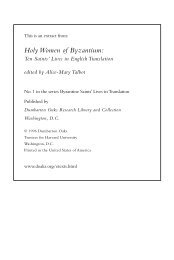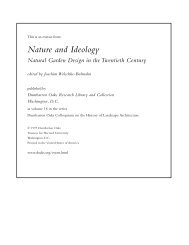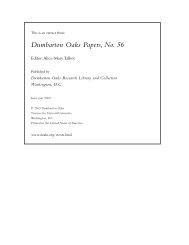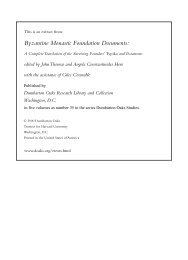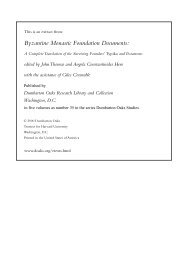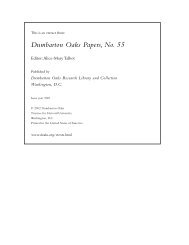The Zooarchaeological Record from Formative ... - Dumbarton Oaks
The Zooarchaeological Record from Formative ... - Dumbarton Oaks
The Zooarchaeological Record from Formative ... - Dumbarton Oaks
You also want an ePaper? Increase the reach of your titles
YUMPU automatically turns print PDFs into web optimized ePapers that Google loves.
<strong>The</strong> <strong>Zooarchaeological</strong> <strong>Record</strong> <strong>from</strong> <strong>Formative</strong> Ecuador<br />
the represented taxa are denizens of easily accessible habitats, ranging <strong>from</strong> brackish<br />
and estuarine conditions, extending seaward to neighboring inshore and nearshore<br />
areas. Although certain fish, like bonefishes (Albula vulpes), may be beached by<br />
wave action or opportunistically scavenged along shorelines, it is reasonable to<br />
suppose that the majority identified in archaeological contexts were actively<br />
pursued, caught, processed, and consumed by prehistoric peoples. It is perhaps<br />
no coincidence that most of the represented taxa are carnivores that readily take<br />
to hook and line. As noted above, shell hook lures are common in coastal Valdivia<br />
assemblages; however, this certainly does not preclude the use of perishable<br />
materials for fishing equipment as cactus spines or plant thorns. Zevallos and<br />
Holm (1960: 7) also suggested the possibility that cotton lines were utilized;<br />
however, the use of wild fibers cannot be ruled out. In either case, many nearshore<br />
carnivores, especially the commonly encountered snooks, sea basses, jacks and<br />
pompanos, snappers, grunts, porgies, drums, barracudas and wrasses could have<br />
been captured through relatively solitary shoreline hook-and-line fishing. This<br />
method could have been supported by trapping or spearing taxa like eels, catfish,<br />
grunts, and drums in shallow and estuarine waters. Still other nearshore<br />
schooling fishes like herrings, croakers, pigfish, and mullets—and surface schoolers<br />
like needlefish—could have been readily procured through communal haul seining.<br />
This is a common sight today along the Ecuadorian coast. <strong>The</strong>se fishermen<br />
hold one end of a long net on the beach while its other end is drawn by boat<br />
around a school of fish, which is eventually hauled ashore.<br />
Access to deeper marine environments was undeniably within the grasp of<br />
the earliest <strong>Formative</strong> inhabitants. Deepwater shell diving could easily have<br />
been supplemented by spearing of reef fishes like cornet and parrotfishes or<br />
inshore toadfishes. Spearing or hook-and-line and net fishing could also have<br />
been undertaken in deeper conditions <strong>from</strong> water craft. Coastal Valdivia assemblages<br />
include stone netweights in their inventories. A number of taxa that<br />
frequent offshore, pelagic, and deepwater environments are included in the<br />
recovered zooarchaeological assemblages. Two notable carnivores in this group,<br />
swordfishes and tunas, take bait; however, their large size and immense power<br />
necessitate an extremely heavy line. Alternatively, their beached carcasses may<br />
also have been occasionally and opportunistically scavenged along the shore,<br />
but the quantity and ubiquity of scombrid deposits in archaeological contexts<br />
argue against this. Interestingly, these taxa have been for the most part uncovered<br />
in Middle <strong>Formative</strong> deposits <strong>from</strong> which bone barbs for composite harpoon<br />
heads have been illustrated (Lathrap et al. 1975: 23, 86); thus harpooning<br />
<strong>from</strong> boats remains a possibility. Similar observations apply for the remains of<br />
sea turtles found in coastal contexts.<br />
185




